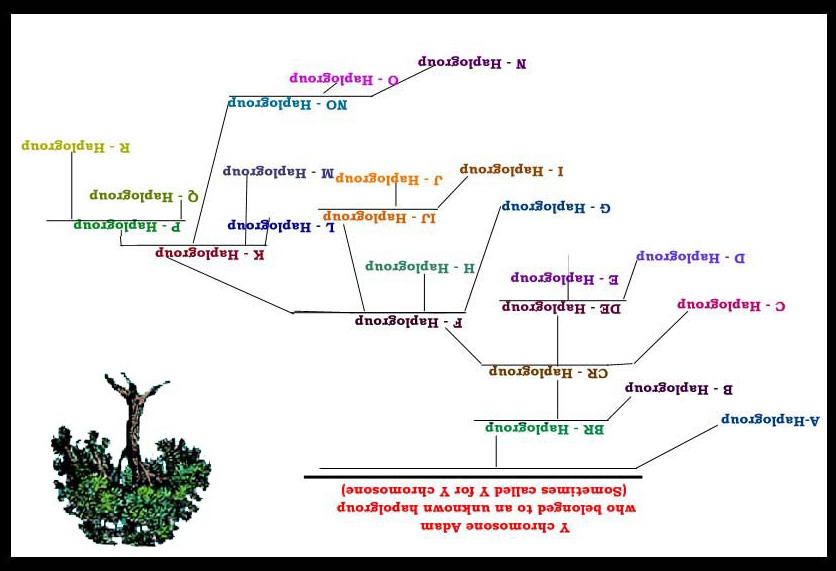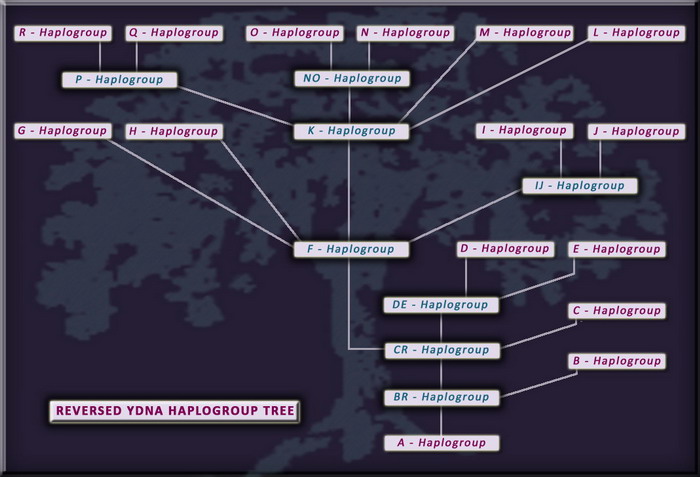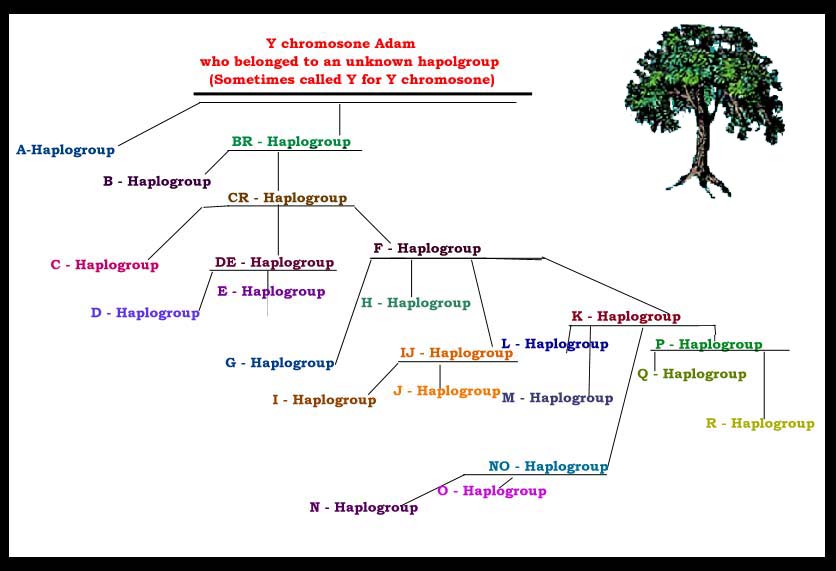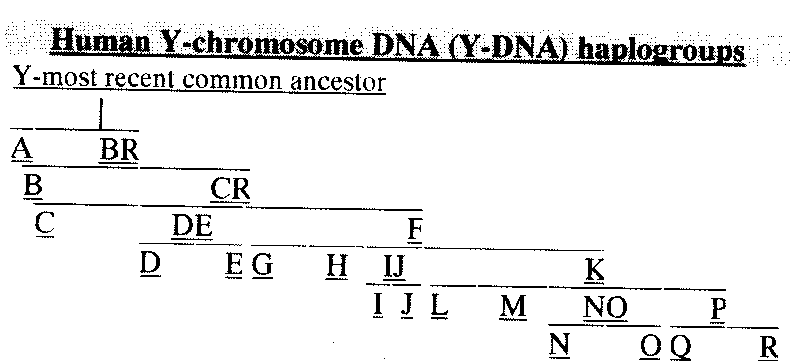YDNA Reversed
Was the ADAM of DNA West European?
Were R1 and N The Forefathers?
The DNA Y(male-transmitted)Haplogroup R (and related) Haplogroups are the most complex. All OTHER haplogroups are contained within them only the others LACK the additions that they have. The commonly accepted theory is that these extra features (of R etc) are the results of later evolution.
Nearly All known observed mutations however result in loss of DNA information, not its increase. It may be both possible and more logical to explain DNA phenomenon by considering the R haplogroups and their kin the PRIMEVAL ones from which the others devolve. This could answer a great many questions and problems that the presently accepted scenario poses.
|
YDNA Reversed
Was the ADAM of DNA West European?
Were R1 and N The Forefathers?
Brit-Am
Was Adam
"R1b1c"?
or "N"?
Was Noah?
The Forefathers? YDNA "Evolutionary" Sequence Reversed
Conventional YDNA uses strands of "Junk" DNA on the Y(male) chromosome that has no known purpose to trace the ancestry and describe the interconnections of human peoples.
These descriptions are valuable in so far YDNA at least in the short run is hereditary. There is a problem however with some of the racial interconnections that are implied by
the conventional explanation. We propose to reverse the commonly accepted assumption that results in anomalies that the conventional explanation proposes.
Below is an illustration we borrowed that depicts Y DNA Haplogroups as presented to the public. It is an evolutionary tree beginning with
the most "simple" of types and devolving from one type to another with increasing complexity.
This depiction presupposes an "evolutionary" development and conclusions that in fact contradict other evidence.
As explained below, it in effect puts most of the Japanese and Tibetans (haplogroup D) in the same major grouping as Africans (DE, E)
and distances them from the Chinese and Koreans (O); It also places East Europeans and West European Celts (R) much closer to Amerindians (Q),
Chinese and Koreans (O), than they are to Scandinavians, North Germanics, Sardinians, Croats (I), and Jews, Greeks, And Arabs (J) and so on.
By reversing the direction of progression however (beginning with the complex R and working down as explained) the above anomalies may be resolved.
In the notes below we briefly describe the conventionally accepted relationships, then we propose to reverse the conception, then we offer three New Possibilities for
Consideration with accompanying diagrams.
This may yet be proven to be one of the most important new ideas put forward in DNA studies and it should not take more than a few minutes to read over.
The Convention DNA Y Haplogroup "Table of Nations"
The conventionally universally accepted presentation of the relationships between YDNA haplogroups is to begin with the "simple"
and proceed to the complex step after step as if each step developed from the previous one.
It (says the theory) all began with A still found in Bushmen etc of Africa.
Followed by B pygmies etc of Africa
Also followed by C and F.
C gave rise to Australian Aborigines, Maoris, Ainu, etc
D and E developed from C.
D are Japanese and Tibetans.
E are Negroid Africans and most African Americans (E3a),
as well as North African Whites, Southeast Europeans, and 20% of Ashkenazic (European) Jews (E3b).
F (which with C developed from A and B) is still found
in small numbers in Indonesia, Middle East, North America.
F gave rise to G H I J and K which split aside.
G (East Europe and Asia), H (India), I (Scandinavians, Germany, Anglo-Saxons, Balkans), J include about a third of the Jews, Turks, Kurds, many Caucasians, and some elements in Balkans etc.
K gave rise to L M and P which split aside.
L and M are Indonesia and much of Southeast Asia with L also present in India and Middle East.
P (Asia and South America) gave rise to N O Q R
N Finland, Russia, Siberia
O Chinese, Koreans and those Japanese who are not D.
Q is Asia and North Amerindians
R Slavs and some "Aryan" Indians (R1a), Celts and West Europeans (R1b), Cameroon Africans, some Australian Aborigines
We see from the above Graph that R (Mainly East and West Europeans, Indian-Aryans) is the final "step" though close to "N" (Finns,Siberians) and "O" (Chinese, Koreans).
There is no "advantage" as to where any one group is found on the "tree".
The Progression is from the "simple" to the "complex".
Within the Haplogroups where there are more examples, i.e. where it is more complex, is considered the "source." Where there are less examples, i.e. where it is more "simple", is considered the offshoot.
There appears to be no reason why what applies within the haplogroup should be not be applicable beyond it.
We propose that the Progression should be reversed, i.e. haplogroup "R" (or haplogroup "N") should be considered "Adam" or rather Noah and all the others offshoots of "R".
It may well be as easy to say that the more complex R was the first "prototype" and all others evolved from it by a process of simplification.
The advantages of this alternate presentation are that,
(a) It allows for a reversal of the "tree". It may now be stood on its head.
(b) It explains several anomalies that the previous conception could not.
(c) It allows for an alternate explanation. It may now be possible to view the progression not in "evolutionary" terms.
Under conventional methods every haplogroup is seen as being the nearest related to the haplogroup most like itself.
This possibility can remain BUT another possibility in some cases may now also be considered.
It is now possible to suggest for instance that "A " was merely a simplified version that "mutated" or emerged directly from R WITHOUT PASSING THROUGH any intermediate stage. The same could apply for all or many of the different haplogroups in question.
It is hoped that somewhere a serious scholar will pick up on the idea and if there is anything to it present it in a format that professional researchers may relate to.
This idea is more in line with what Creationists may accept but that is not why we advocate it or expect it to be accepted.
It simply may well be closer to the truth and allow a renewed appraisal of how the different Y chromosome haplogroups may relate to each to other.
New Possibility for Consideration no.1
The haplogroups evolved from each other but in reverse order from what is commonly depicted,
i.e. beginning from "N" and "R" they "lost" something of their complexity resulting in "A".
According to this suggestion t the YDNA "evolutionary" tree should be reversed:
Instead of beginning with A (Bushmen in Africa) and proceeding
to R (East and West Europeans) becoming more and more complex in each stage "forward" it should begin with R
and proceed to A becoming more simple.
The note below remarking that all preceived mutations in DNA result in a loss
of information strengthens this suggestion.
JOES CREATIONISM VS EVOLUTION WEB PAGE
http://members.aol.com/BrainMan10/create1.html
Extract:
#2. All observed mutations cause a loss of DNA information.
Example - all experiments in the laboratory that involve the DNA of mutated specimens always show a loss of DNA information, for evolution to truly take place there must be the addition of new data to the DNA chain - yet this has never been the case. In fact many evolutionist always show animals that have loss some feature (de-evolution) and hold that up as an example of evolution.
If one does not bind oneself to Evolutionary Dogma then our YDAN proposal (that it stared with R and proceeded "downwards")
should be the more scienfically acceptable. It accords with all observed phenomenon. It is also the simplest possible explanation.
Conventional YDNA chart turned on its head. See next diagram.

|
Conventional YDNA chart turned on its head.
Diagram
by Estelle Schutte
.

|
New Possibility for Consideration no.2
Some of the haplogroups evolved directly from "R",
e.g. beginning from "R" the next stage "lost" something of its complexity and became "F" and from "F" evolved G, H, IJ, and K as conventionally depicted.
New Possibility for Consideration no.3
All of the haplogroups evolved at different times directly from a Forefather "R",
e.g. beginning from "R" the next stages "lost" varying degrees of their complexity and became the resultant haplogroups existing today. This would help explain such anomalies as R1b samples turning up in the Cameroons of West Africa and amongst Australian Aborigines as local products and not as a result of foreign intrusion.
This possibility is shown in the diagram below:
|
R
|
| R1 | R2 | R3 |
R4 | R5 | R6 | R7 | R8 |
R9 | R10 | R11 | R12 | R13 |
R14 | R15 | R16 | R17 | R18 |
R19 | R20 | R21 |
| A | B | BR |
C | CR | E | DE | D |
F | G | H | IJ | K |
L | M | NO | O | N |
P | Q | R |
New Possibility for Consideration no.4
YDNA haplogroups are like all other physical phenomena (eye color, blood type, etc) in that they have both herditary and autosomal explanations.
This would mean that YDNA is indeed in part hereditary and can be used to trace familial relationships. It may also occur in different unrelated specimens due to environmental or other factors. Once a change appears, though caused by external influences, it remains imprinted and transmits its alteration through hereditry.
See:
DNA Racial Classifications Refuted!
Main Page
Offerings and Publications



